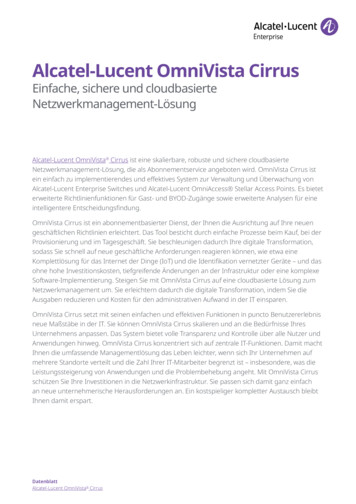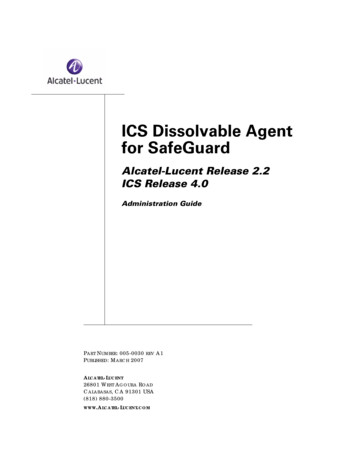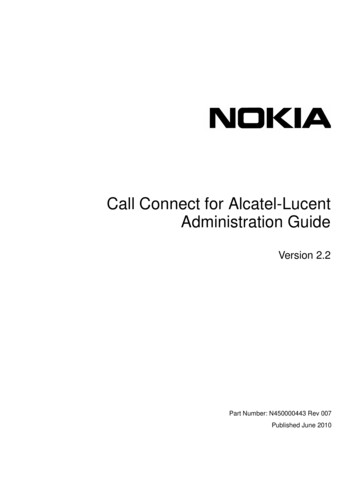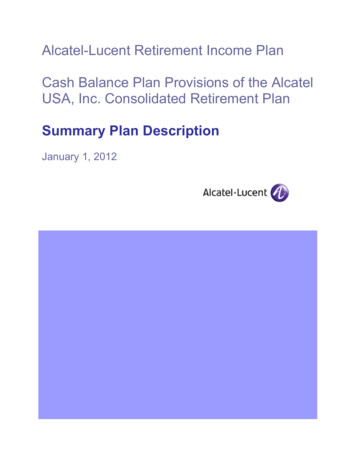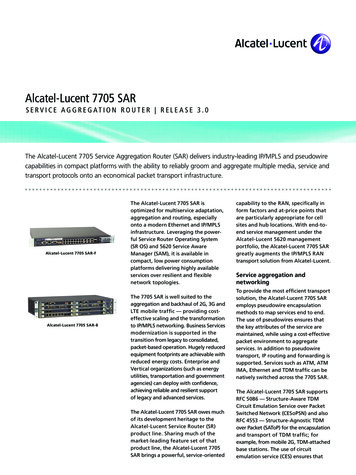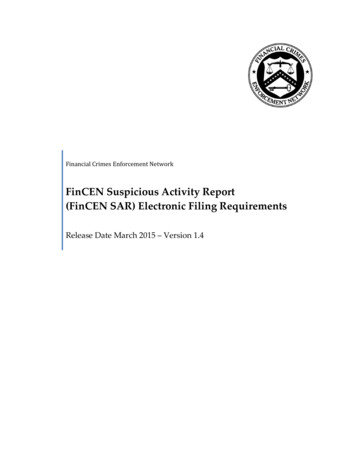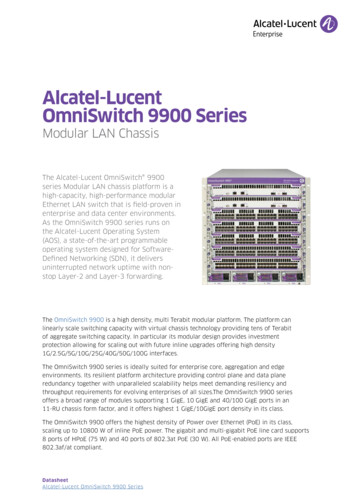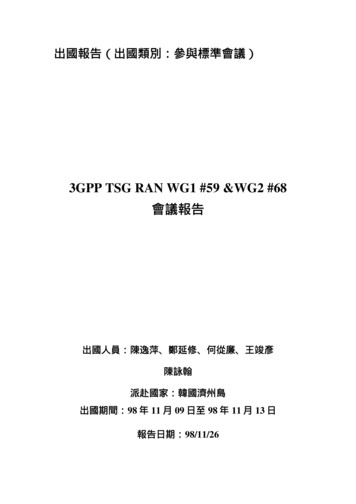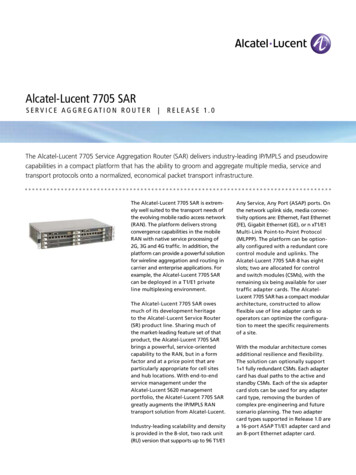
Transcription
Alcatel-Lucent 7705 SARS E R V I C E A G G R E G A T I O N R O U T E R R E L E A S E 1 . 0The Alcatel-Lucent 7705 Service Aggregation Router (SAR) delivers industry-leading IP/MPLS and pseudowirecapabilities in a compact platform that has the ability to groom and aggregate multiple media, service andtransport protocols onto a normalized, economical packet transport infrastructure.The Alcatel-Lucent 7705 SAR is extrem ely well suited to the transport needs ofthe evolving mobile radio access net work(RAN). The platform delivers strongconvergence capabilities in the mobileRAN with native service processing of2G, 3G and 4G traffic. In addition, theplatform can provide a powerful solutionfor wire line aggre gation and routing incarrier and enterprise applications. Forexample, the Alcatel-Lucent 7705 SARcan be deployed in a T1/E1 privateline multiplexing environment.The Alcatel-Lucent 7705 SAR owesmuch of its development heritageto the Alcatel-Lucent Service Router(SR) product line. Sharing much ofthe market-leading feature set of thatproduct, the Alcatel-Lucent 7705 SARbrings a powerful, service-orientedcapability to the RAN, but in a formfactor and at a price point that areparticularly appropriate for cell sitesand hub locations. With end-to-endservice management under theAlcatel-Lucent 5620 managementportfolio, the Alcatel-Lucent 7705 SARgreatly augments the IP/MPLS RANtransport solution from Alcatel-Lucent.Industry-leading scalability and densityis provided in the 8-slot, two rack unit(RU) version that supports up to 96 T1/E1Any Service, Any Port (ASAP) ports. Onthe network uplink side, media connec tivity options are: Ethernet, Fast Ethernet(FE), Gigabit Ethernet (GE), or n xT1/E1Multi-Link Point-to-Point Protocol(MLPPP). The platform can be optionally configured with a redundant corecontrol module and uplinks. TheAlcatel-Lucent 7705 SAR-8 has eightslots; two are allocated for controland switch modules (CSMs), with theremaining six being available for usertraffic adapter cards. The AlcatelLucent 7705 SAR has a compact modulararchitecture, constructed to allowflexible use of line adapter cards sooperators can optimize the configuration to meet the specific requirementsof a site.With the modular architecture comesadditional resilience and flexibility.The solution can optionally support1 1 fully redundant CSMs. Each adaptercard has dual paths to the active andstandby CSMs. Each of the six adaptercard slots can be used for any adaptercard type, removing the burden ofcomplex pre-engineering and futurescenario planning. The two adaptercard types supported in Release 1.0 area 16-port ASAP T1/E1 adapter card andan 8-port Ethernet adapter card.
The ASAP adapter card supports ATM,inverse multiplexing over ATM (IMA),TDM and MLPPP. The Ethernet adaptercard has six ports of auto-sensing 10/100Base-T ports plus two further portssupporting 10/100/1000 Base TX withsmall form factor pluggable (SFPs) optics.Each slot is connected to the switchingfabric on the CSM via a 1 Gb/s link to hostexisting and future interface types.Service aggregationand networkingTo provide the most efficient transportsolution, the Alcatel-Lucent 7705 SARemploys pseudowire encapsulation(PWE3) methods to map services endto end. The use of pseudowires ensuresthat the key attributes of the serviceare maintained, while using a costeffective packet environment toaggregate services.The Alcatel-Lucent 7705 SAR supportsRFC 5086 — Structure-Aware TimeDivision Multiplexed (TDM) CircuitEmulation Service over Packet SwitchedNetwork (CESoPSN) for the encap su lation and transport of TDM traffic,for example, 2G TDM services. The useof circuit emulation service (CES) ensuresthat only the active timeslots aretransported, keeping bandwidth usageto a minimum. The Alcatel-Lucent 7705SAR also supports RFC 4717 — Encapsu lation Methods for Transport ofAsynchronous Transfer Mode (ATM)over MPLS Networks (also known asdraft-ietf-pwe3-atm-encap). TheAlcatel-Lucent 7705 SAR supports N:1cell mode for transport of ATM-basedservices. Multiple access ATM ports arebundled together to attain higherspeeds using IMA. The IMA protocolis terminated on the Alcatel-Lucent7705 SAR and only the cells containinguser data belonging to a virtualcircuit/virtual path (VC/VP) structureare transported.In addition, the Alcatel-Lucent 7705SAR supports RFC 4448 — Encapsu lation Methods for Transport ofEthernet over MPLS Networks, whichspecifies how Ethernet pseudowirescan be used to transport Ethernettraffic across the packet network. Tooffer greater scalability, all the trafficout of an Ethernet port can be carriedover a single Ethernet pseudowire or,alternatively, a pseudowire can becreated for each VLAN that is assignedto a different service or end-customer.When dynamic signaling is deployed,the end-to-end pseudowire is established using targeted label distributionprotocol (T-LDP) and the MPLS tunnelvia LDP. In addition to efficientLDP-based dynamic signaling, staticprovisioning of both the MPLS tunneland the pseudowire is also supported.Quality of service andtraffic managementIt is critical to maintain the end-to-endquality of service (QoS) for packet traffic.Not all types of traffic have the sameset of requirements. Voice traffic inparticular requires low latency andjitter (latency variation) and also lowloss, whereas data traffic often hasless stringent delay requirements butmay be very sensitive to loss, as packetloss can seriously constrain applica tion throughput. To offer the req uired treatment throughout thenetwork, traffic flows with differentrequire ments are identified at theaccess and marked in-line with theappropriate QoS metrics. Trafficclassification and marking is carriedout based on the following:Classification (Layer 1/Layer 2/Layer2.5 and/or Layer 3 header): Timeslot/port Ethernet port/VLAN ATM service category(CBR/rt-VBR/nrt-VBR/UBR) ATM VC Ethernet 802.1p/VLAN IP DSCP/MPLS EXPMarking: Layer 2 (802.1p) Layer 2.5 (EXP) both for tunneland PWE3 Layer 3 (DiffServ)Figure 1. Low-cost, high-quality backhaul using MPLS pseudowiresCell SiteBTSMTSO7705 SARTDMTDMEthernet, MLPPPATMNode BEthernet7705SARPSN/Metro Ethernet/SONET/SDHATMEthernet, MLPPP7710/7750 SR,7670 RSPTelemetryTDM PseudowireMPLS TunnelATM PseudowireEthernet PseudowireMPLS Pseudowires Allow Convergence and Dynamic Bandwidth AllocationOver Multiple Media, Enabling Low Cost Backhaul2Alcatel-Lucent 7705 SAR Data SheetBSCEthernetRNC
The Alcatel-Lucent 7705 SAR utilizesextensive traffic management policiesto ensure fairness with detailedclassification and hierarchical scheduling including minimum/maximum,profiled, round robin and strict priorityscheduling and multi-tier policing todifferentiate and prioritize individualservices and flows.Operations, administrationand maintenanceIn order to ensure continuity ofservices, the Alcatel-Lucent 7705 SARhas a full set of operations, adminis tration and maintenance (OAM)features including: LSP ping LSP traceroute Service distribution path (SDP) ping Verifies, for example, tunnelconnectivity and round trip delay Virtual circuit connectivityverification (VCCV) Verifies, for example, service levelexistence and round trip time Extends OAM to pseudowireservices Service Assurance Agent (SAA) Runs in background, periodicallycollecting network “health” information from OAM mecha nisms suchas VCCV and moni toring for problems such as SLA transgressions.These features, when under thecontrol of the Alcatel-Lucent 5620management portfolio, ensure rapidfault detection as well as efficienttroubleshooting. In particular, SLAscan be monitored, and transgressionsdetected and reported via the SAA.SynchronizationCell sites rely on the backhaul networkto provide synchronous interfaces forthe proper delivery of data. In addition,cell sites may rely on the networkinterfaces as stable references withwhich to derive radio frequencies (RFs)and in order to ensure reliable subscriberhandover between cell towers.The Alcatel-Lucent 7705 SAR supportsexternal reference timing, line timingand adaptive timing in Release 1.0.The adaptive timing is fully capable ofoffering end-to-end synchronization.In addition, the Alcatel-Lucent 7705SAR is completely hardware-ready tosupport IEEE1588v2. This IEEE standarddefines a method to minimize theeffects of delay and delay variation(jitter). This is accomplished by a combi nation of built-in architectural featuresand also powerful QoS mechanisms tominimize the delay experienced bysynchronization traffic. This is a corner stone of the design of the Alcatel-Lucent7705 SAR. A built-in Stratum-3 clock isavailable in the control and switch moduleto assist in synchro nization maintenance.Features Cost-effective migration from E1/T1-based backhaul to packet-basedtransport, leveraging Ethernet services over a wide range of first milemedia.Benefits Transition from PDH-basedconnec tivity to Ethernet-basedcan greatly reduce recurringoperating expenditures suchas line lease costs. Advanced resiliency features leadto improved network uptime, whichcan positively impact customer retentionand allow critical services to beoffered for increased revenue. Rapid fault detection and powerfulcommissioning and troubleshootingtools can improve productivity ofoperations staff and reduce networkdowntime. Multiprotocol and convergencecapabilities (with flexible andgranular QoS) reduce equipmentinstances needed to carry multiplefixed and mobile traffic streams. Modular, flexible architecturealleviates the burden of complexpre-engineering and futurescenario planning. Resiliency and redundancy including:one-for-one hitless control and switchmodule failover, synchronization redundancy, network uplink resiliencyand redundancy of power feeds. Powerful, service-aware OAMcapabilities complemented by theAlcatel-Lucent 5620 managementportfolio for GUI-based networkand element configuration, provisioning, fault and performancemanagement. Dense adaptation of multiple converged services onto an economicalpacket infrastructure. Extends service routing IP/MPLScapabilities to the cell site, hubsand network edge in a compactform factor. Dynamic tunnel signaling for scaling,ease of establishment and resiliency.Alcatel-Lucent 7705 SAR Data Sheet3
Technical specificationsModules and adapter cards Control and switch module (CSM) 8-port Ethernet adapter card(six ports of 10/100 Ethernet, twoports of 10/100/1000 Ethernet) 16-port T1/E1 Any Service, AnyPort (ASAP) adapter cardServices TDM pseudowires RFC 5086 Structure-AwareTime Division Multiplexed(TDM) Circuit Emulation Serviceover Packet Switched Network(CESoPSN) ATM pseudowires RFC 4717 EncapsulationMethods for Transport ofAsynchronous Transfer Mode(ATM) over MPLS Networks N:1 cell mode, virtual circuitconnection and virtual pathconnection ATM IMA Ethernet pseudowires RFC 4448 EncapsulationMethods for Transport ofEthernet over MPLS Networks Raw and tagged modeSynchronization External reference timingLine timingAdaptive timingBuilt-in Stratum-3 clockHardware-ready to supportIEEE 1588v2Redundancy and resiliency ControlFabricSynchronizationUplinksMPLS tunnelPower feedsTraffic management and QoS Hierarchical queuing Multi-tier scheduling Profiled (in and out of profile)scheduling Queue type-based scheduling Ingress policing and egress shaping Up to 8 queues per service Memory allocation per queue(CBS, MBS per queue) Premium, assured and best-effortforwarding classes WRED on ingress and egress Classification based on: Layer 1/Layer 2/Layer 2.5and/or Layer 3 header Timeslot/port Ethernet port/VLAN ATM service category:(CBR/rt-VBRrt-VBR/UBR) ATM VC Ethernet 802.1p/VLAN IP DSCP/MPLS EXP Marking based on: Layer 2 (802.1p) Layer 2.5 (EXP) both fortunnel and PWE3 Layer 3 (DiffServ)Security (node access) User ID/password-basedauthentication and authorization Exponential login backofffor brute force attacks Local or remote storingof user-info Remote authentication/authorization via RemoteAuthentication Dial In UserService (RADIUS) and TerminalAccess Controller Access-ControlSystem (TACACS) Secure Shellv2, Secure FileTransfer Protocol and SimpleNetwork Management Protocol(SNMP) Version 3 Secure open interfaces Syslog Capture security logs onlocal or remote server Alarm on suspicious sequenceof operations Nodal attack Basic firewall with filteringof control plane traffic Denial of service (DoS) attackprevention (rate-limiting andprioritization) Data security Transfer over peer-to-peer tunnel(MPLS) MD5 authentication Sequence numbers preventreplaying of data Statistics available on suspiciousbehaviorManagementProtocol support Fully-featured, industry-standardcommand line interface Port and service mirroring Service assurance tools, includingLSP ping, LSP traceroute, SDPping, VCCV SSH and Telnet FTP, Trivial File Transfer Protocoland Secure Copy Protocol RADIUS (AAA) TACACS SNMP v2/v3LDPSafety standards andregulatory compliance Safety: CSA 60950-1 2001 EMC: EN55022 1998 (Class A) FCC Part 15 - 2003 (Class A)Physical dimensions Height: 2 RU, 8.9 cm (3.5 in.)Depth: 25.4 cm (10 in.)Width: 48.3 cm (19 in.)Rack mountable in a 30 cm x45 cm (11.8 in x 17.7 in.) rackPower -48v feeds, 180 W maximumdrawCooling One tray of eight fansOperating environment Normal operating temperaturerange: -5 C to 45 C(23 F to 113 F) Short term (96 hours) extendedtemperature range: -5 C to 55 C(23 F to 131 F) Normal humidity: 5% to 85% Short term (96 hours) extendedhumidity range: 5% to 95%Standards and protocolsStandards compliance IEEE 802.1p/Q VLAN TaggingIEEE 802.3 10BaseTIEEE 802.3u 100BaseTXIEEE 802.3x Flow ControlIEEE 802.3z 1000BaseSX/LX RFC 5036 LDP SpecificationMPLS RFC 3031 Multiprotocol LabelSwitching Architecture RFC 3032 MPLS Label StackEncoding RFC 4379 Detecting MultiProtocol Label Switched(MPLS) Data Plane FailuresDifferentiated services RFC 2474 Definition of theDifferentiated Services Field(DS Field) in the IPv4 andIPv6 Headers RFC 2597 AssuredForwarding PHB Group RFC 2598 An ExpeditedForwarding PHB RFC 3140 Per Hop BehaviorIdentification CodesTCP/IP RFC 768 User Datagram Protocol RFC 1350 The TFTP Protocol(Revision 2) RFC 791 Internet Protocol RFC 792 Internet ControlMessage Protocol RFC 793 Transmission ControlProtocol RFC 826 Ethernet AddressResolution Protocol RFC 854 Telnet ProtocolSpecification RFC 1812 Requirementsfor IPv4 RoutersPPP RFC 1332 PPP Internet ProtocolControl Protocol (IPCP) RFC 1661 The Point-to-PointProtocol (PPP) RFC 1989 PPP Link QualityMonitoring RFC 1990 The PPP MultilinkProtocol (MP)ATM RFC 2514 Definitions ofTextual Conventions andOBJECT-IDENTITIES for ATMManagement, February 1999 RFC 2515 Definition of ManagedObjects for ATM Management,February 1999 af-tm-0121.000 TrafficManagement SpecificationVersion 4.1, March 1999Alcatel-Lucent 7705 SAR Data Sheet4
ITU-T RecommendationI.610 – B-ISDN Operation andMaintenance Principles andFunctions version 11/95 ITU-T Recommendation I.432.1 –B-ISDN user-network interface –Physical layer specification:General characteristics GR-1248-CORE – GenericRequirements for Operationsof ATM Network Elements (NEs)Issue 3 June 1996 GR-1113-CORE – AsynchronousTransfer Mode (ATM) AdaptationLayer (AAL) Protocols GenericRequirements, Issue 1, July 1994Pseudowires RFC 4447 Pseudowire Setup andMaintenance using the LabelDistribution Protocol (LDP) RFC 4385 Pseudowire EmulationEdge-to-Edge (PWE3) ControlWord for Use over an MPLS PSN RFC 4717 Encapsulation Methodsfor Transport of AsynchronousTransfer Mode (ATM) over MPLSNetworks RFC 4448 Encapsulation Methodsfor Transport of Ethernet overMPLS Networks RFC 5086 Structure-AwareTime Division Multiplexed(TDM) Circuit Emulation Serviceover Packet Switched Network(CESoPSN) RFC 5085 Pseudowire VirtualCircuit Connectivity Verification(VCCV): A Control Channel forPseudowiresRADIUS RFC 2865 Remote AuthenticationDial In User Service (RADIUS) RFC 2866 RADIUS AccountingSSH draft-ietf-secsh-architecture.txtSSH Protocol Architecture draft-ietf-secsh-userauth.txtSSH Authentication Protocol draft-ietf-secsh-transport.txtSSH Transport Layer Protocol draft-ietf-secsh-connection.txtSSH Connection Protocol draft-ietf-secsh- newmodes.txtSSH Transport Layer EncryptionModesTACACS IETF draft-grant-tacacs-02.txtNetwork Management ITU-T X.721: Informationtechnology-OSI-Structureof Management Information ITU-T X.734: Informationtechnology-OSI-SystemsManagement: Event ReportManagement Function M.3100/3120 Equipmentand Connection Models TMF 509/613NetworkConnectivity Model RFC 1157 SNMPv1 RFC 1907 SNMPv2-MIB RFC 2011 IP-MIB RFC 2012 TCP-MIB RFC 2013 UDP-MIB RFC 2138 RADIUS RFC 2571 SNMP-Framework-MIB RFC 2572 SNMP-MPD-MIB RFC 2573 SNMP-Applications RFC 2574 SNMP-User-BasedSM-MIB RFC 2575 SNMP-View-BasedACM-MIB RFC 2576 SNMP-COMMUNITYMIB RFC 2665 Ethernet-Like-MIB RFC 2819 RMON-MIB RFC 2863 The InterfacesGroup-MIB RFC 2864 Inverted-Stack-MIB RFC 3014 Notification-Log-MIB RFC 3273 HCRMON-MIB RFC 3411 An Architecture forDescribing Simple NetworkManagement Protocol (SNMP)Management Frameworks RFC 3412 Message Processingand Dispatching for the SimpleNetwork Management Protocol(SNMP) RFC 3413 Simple NetworkManagement Protocol (SNMP)Applications RFC 3414 User-based SecurityModel (USM) for version 3 of theSimple Network ManagementProtocol (SNMPv3) RFC 3418 SNMP MIB draft-ietf-disman-alarm-mib-04.txt draft-ietf-mpls-ldp-mib-07.txt IANA-ifType-MIBSupport for an extensive rangeof proprietary MIBsAlcatel-Lucent 7705 SAR Data Sheet5
www.alcatel-lucent.comAlcatel, Lucent, Alcatel-Lucent and the Alcatel-Lucent logoare trademarks of Alcatel-Lucent. All other trademarks are the property of their respective owners.The information presented is subject to change without notice. Alcatel-Lucent assumes no responsibilityfor inaccuracies contained herein. 2008 Alcatel-Lucent. All rights reserved. CAR4688080501 (05)
Any Service, Any Port (ASAP) ports. On the network uplink side, media connec - tivity options are: Ethernet, Fast Ethernet (FE), Gigabit Ethernet (GE), or n xT1/E1 Multi-Link Point-to-Point Protocol (MLPPP). The platform can be option-ally configured with a redundant core control module and uplinks. The Alcatel-Lucent 7705 SAR-8 has eight
